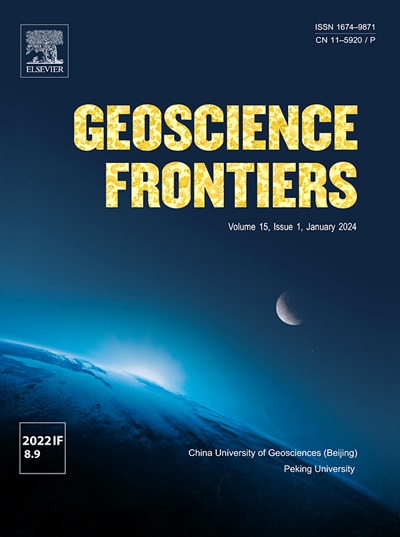基于空间异质性和机器学习模型的坡地覆盖层厚度预测
IF 8.9
1区 地球科学
Q1 GEOSCIENCES, MULTIDISCIPLINARY
引用次数: 0
摘要
覆盖层厚度的空间分布对滑坡易感性预测和边坡稳定性分析具有重要意义。由于坡地OLT的空间异质性,加之OLT样本采集的难度和耗时,准确预测OLT分布仍然是一个挑战。为了解决这个问题,开发了一个新的框架。首先,通过野外调查、遥感和地质钻探采集OLT样本。其次,利用OLT样本的概率分布及其水平和垂直分布分析OLT空间分布的异质性。对OLT样本进行分类,并使用合成少数派过采样技术(SMOTE)扩展小样本类别。选取边坡位置作为关键的调节因素。随后,采用随机森林回归算法,应用16个条件因子构建OLT预测模型。为每个OLT样本类别分配权重,以平衡样本大小分布的不均匀性。最后,采用Pearson相关系数、平均绝对误差(MAE)、均方根误差(RMSE)和Lin’s一致性相关系数(Lin’s CCC)对OLT预测结果进行验证。黄滩镇就是一个研究案例。结果表明:(1)异质性分析、基于smote的OLT样本扩展策略和坡位选择能够显著缓解空间异质性对OLT预测的影响。(2) Pearson相关系数、RMSE、MAE和Lin’s CCC值分别为0.84、1.173、1.378和0.804,预测效果良好。该研究为预测丘陵地区OLT分布提供了有效的解决方案。本文章由计算机程序翻译,如有差异,请以英文原文为准。

Prediction of overburden layer thickness based on spatial heterogeneity analysis and machine learning models in hillslope regions
The spatial distribution of overburden layer thickness (OLT) is crucial for landslide susceptibility prediction and slope stability analysis. Due to OLT spatial heterogeneity in hillslope regions, combined with the difficulty and time consumption of OLT sample collection, accurately predicting OLT distribution remains a challenging. To address this, a novel framework has been developed. First, OLT samples are collected through field surveys, remote sensing, and geological drilling. Next, the heterogeneity of OLT’s spatial distribution is analyzed using the probability distribution of OLT samples and their horizontal and vertical distributions. The OLT samples are categorized and the small sample categories are expanded using the synthetic minority over-sampling technique (SMOTE). The slope position is selected as a key conditioning factor. Subsequently, 16 conditioning factors are applied to construct OLT prediction model using the random forest regression algorithm. Weights are assigned to each OLT sample category to balance the uneven distribution of sample sizes. Finally, the Pearson correlation coefficient, mean absolute error (MAE), root mean square error (RMSE), and Lin’s concordance correlation coefficient (Lin’s CCC) are employed to validate the OLT prediction results. The Huangtan town serves as the case study. Results show: (1) heterogeneity analysis, SMOTE-based OLT sample expansion strategy and slope position selection can significantly mitigate the effect of spatial heterogeneity on OLT prediction. (2) The Pearson correlation coefficient, RMSE, MAE and Lin’s CCC values are 0.84, 1.173, 1.378 and 0.804, respectively, indicating excellent prediction performance. This research provides an effective solution for predicting OLT distribution in hillslope regions.
求助全文
通过发布文献求助,成功后即可免费获取论文全文。
去求助
来源期刊

Geoscience frontiers
Earth and Planetary Sciences-General Earth and Planetary Sciences
CiteScore
17.80
自引率
3.40%
发文量
147
审稿时长
35 days
期刊介绍:
Geoscience Frontiers (GSF) is the Journal of China University of Geosciences (Beijing) and Peking University. It publishes peer-reviewed research articles and reviews in interdisciplinary fields of Earth and Planetary Sciences. GSF covers various research areas including petrology and geochemistry, lithospheric architecture and mantle dynamics, global tectonics, economic geology and fuel exploration, geophysics, stratigraphy and paleontology, environmental and engineering geology, astrogeology, and the nexus of resources-energy-emissions-climate under Sustainable Development Goals. The journal aims to bridge innovative, provocative, and challenging concepts and models in these fields, providing insights on correlations and evolution.
 求助内容:
求助内容: 应助结果提醒方式:
应助结果提醒方式:


